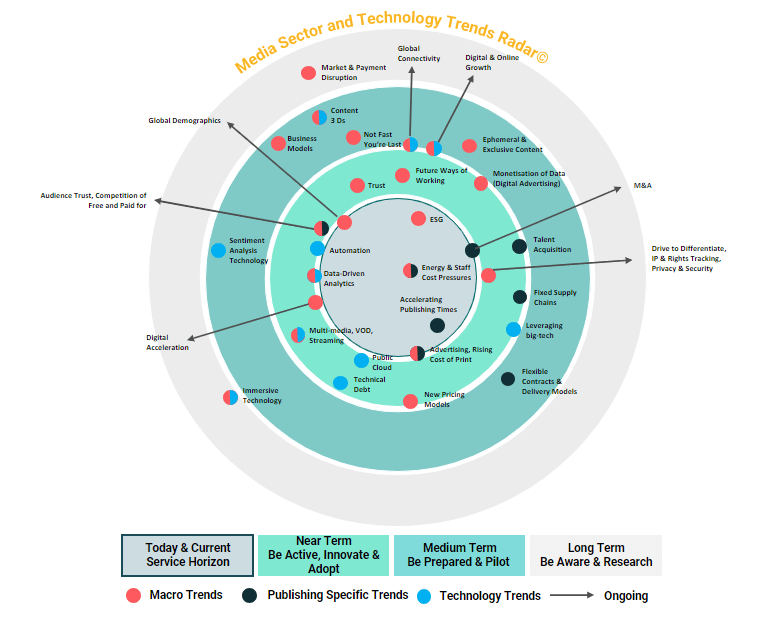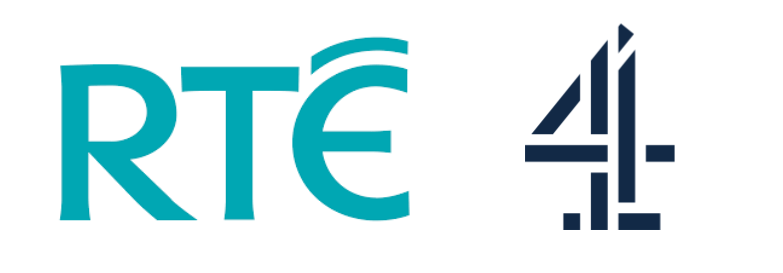6 min read
Media Sector Trends Radar – 2024 and Beyond
Read time: 10 mins
Introduction
We present this third and final part of our series on the media sector. This blog follows the introduction of our Media Sector Impact Dial and Media Sector Trends and Challenges 2023, which set the scene for what follows.
As established, the media sector is diverse and our infographic Sector Impact Dial set out the vast range of influences on the sector. This included the global online market, content disruption, and organisational change to commerce. All these influences, challenges and trends need to be set into some context and within some understanding of how the media sector might embrace these within an outline roadmap – and in what timeframes.
- Version 1 Sector & Technology Trends Radar
- Today & Current Service Horizon
- Near Term – Be Active, Innovate and Adopt
- Medium Term – Be Prepared and Pilot
- Long Term – Be Aware and Research
- Version 1’s Media Sector Experience
Version 1 Sector & Technology Trends Radar
We discussed a wide range of topics in our Sector Impact Dial which all paint a rich picture of future change. Although not all changes can be predicted, some are identifiable and can be tracked, researched, tested, and adopted, if necessary. Change that is not identifiable often requires the resilience of the organisation to adapt. The recent global pandemic has been a valuable lesson for most organisations in this regard.
Version 1 uses a 3-step methodology to track change, trends, and emerging challenges. We look at this through 3 time horizons:
- Near term horizon
- Medium term horizon
- Long term horizon
A 4th term, the ‘today’ is considered the event horizon for current services and technology solutions in mainstream and wide adoption. This is not to say these are not themselves subject to future change and innovation.
Against the 3 time horizons, we define 3 activity-based approaches, which are:
Be Active, Innovate and Adopt for the near horizon.
Be Prepared and Pilot for the medium-term horizon.
Be Aware and Research for the long-term horizon.
Importantly, for some organisations, some trends will be more near-term than others depending on the position within the adoption cycle that applies to their specific circumstances i.e., are they innovators, early adopters, late adopters, or laggards?
Regardless of your posture on technology adoption, we recommend that trends over these terms should be based on the identifiable benefit they bring i.e., do they provide operational, business, financial, or other benefits that can be identified, quantified, and realised. If they are of no meaningful benefit, there is no point in adoption.
Using the time horizons and the activity-based approaches discussed above we can represent how the macro trends we outlined in our previous blogs and the specific factors in the publishing sector would align with our Sector and Technology Trends Radar. See Figure 1 below.
Some trends will exist across all terms in some form (shown by an arrow).

Today & Current Service Horizon
The ‘today’ and ‘current service’ horizon covers trends that are already impacting the sector, that you should already be addressing. In our previous blogs, we discussed the impact of global demographics, and how that is driving the need for digital content, distributed via diverse channels. With changing demographics, nothing here stands still, and what seems like today’s unlikely use case is the future mainstream channel e.g., the worlds of AR and VR.
ESG is becoming a fundamental capability of all organisations, and consumers and employees alike will be placing greater emphasis on the organisations they buy or work from to be socially responsible and environmentally minded.
We covered the pressures on staffing, including supply and demand through to retention against recent trends. In publishing, we highlighted the recent rise in energy costs directly impacting the cost of print and the need for traditional publishers to consider accelerating publishing times and shorter content supply chains to keep up with the competition. Mergers and acquisitions (M&A), like so many other industries, will increasingly focus on acquiring capability and differentiators that add value, revenue, new channels, or markets.
Regarding revenue, we discussed the need to harness data-driven insight to provide targeted advertising, particularly around engagement with digital content.
Near Term – Be Active, Innovate and Adopt
Moving to the near term, these are trends you should already be moving towards.
Trust in media and content
We discussed the importance of trust in the media, in a day and age of ‘fake news’, deep-fake videos and data breaches. We also discussed trust in the context of content itself, that it is free of bias or emotion, and that your content supply chain is also free of the same.
Future ways of working
As we move forward future ways of working will determine how flexible you are with your workforce and with your supply chain, embracing internal and external change. You will need to consider a post-pandemic reality of staff expectations coupled with the 3 Ds of content – disruption, distribution, and de-centralisation.
Advanced Digital Advertising
An advanced view of digital advertising will drive the monetisation of data, knowing what your readership or audience likes or wants and turning those profiles into compelling personalised advertising content. Talent acquisition strategies will need to come into play, and you’ll increasingly need to consider the expectations from new talent for environmental credentials, flexible working, and more.
Differentiation and Content Protection
Near term, your drive to differentiate will need to be matched by your drive to track and protect your content and IP. This will go hand-in-hand with ensuring readership, viewer or subscriber privacy, and the security of their data. Failures in this area can cause lasting and fatal damage to media organisations. The traditional fixed supply chain for content will no longer be as fixed and you may need to embrace content supply chains that borrow from social platforms, influencers, freelancers, and the public at large. Such a diverse supply chain may heighten the need to ensure trust is maintained through the editing processes.
should be a key part of any change strategy, whether that be harnessing social media platforms to reach a wider demographic or utilising the public cloud as a vehicle for modernisation and transformation. Gartner predicts that by 2025 cloud-native platforms will be the foundation for more than 95% of new digital initiatives, up from less than 40% in 2021 (Gartner). That need to modernise will be driven by a requirement to manage the constraints of technical debt which can stifle progress and harm a media outlet. It is a stark figure that McKinsey estimates 20-40% of IT budgets are dedicated to addressing technical debt and worse, 20% of new product budget is channelled to do the same. Digital Acceleration is therefore a must for media, to leapfrog the competition.
New pricing models may need to be considered, with a 10% year-on-year increase in digital methods of payment forcing media organisations to consider how to price and enable flexible payment options. The decline of print over digital is one such example of how newspapers have had to look to digital channels and content for new revenue. Such models will need to consider diversification of channels, multi-media, VOD and streaming to ensure that they remain competitive. Competition will drive the need for increased automation and efficiency in your content supply chain whilst ensuring audience trust.
Medium Term – Be Prepared and Pilot
In the medium term, we identify several areas to prepare for, including:

Long Term – Be Aware and Research

Version 1’s Media Sector Experience
We come with an understanding of the media sector across the UK and Ireland. This includes well-known broadcasters, publishers, and content providers. We are a trusted partner to operate, innovate and transform services across established players, including:
- International Published and Radio Broadcaster
- UK and Irish Newspapers
- European Telecommunications, and,
- National Broadcasters such as

Our collective experience tells us that things are moving quickly across the sector, but that the fundamental priority is still developing and distributing engaging, and increasingly digital content to drive audience growth and data-driven advertising. Talk to us today.